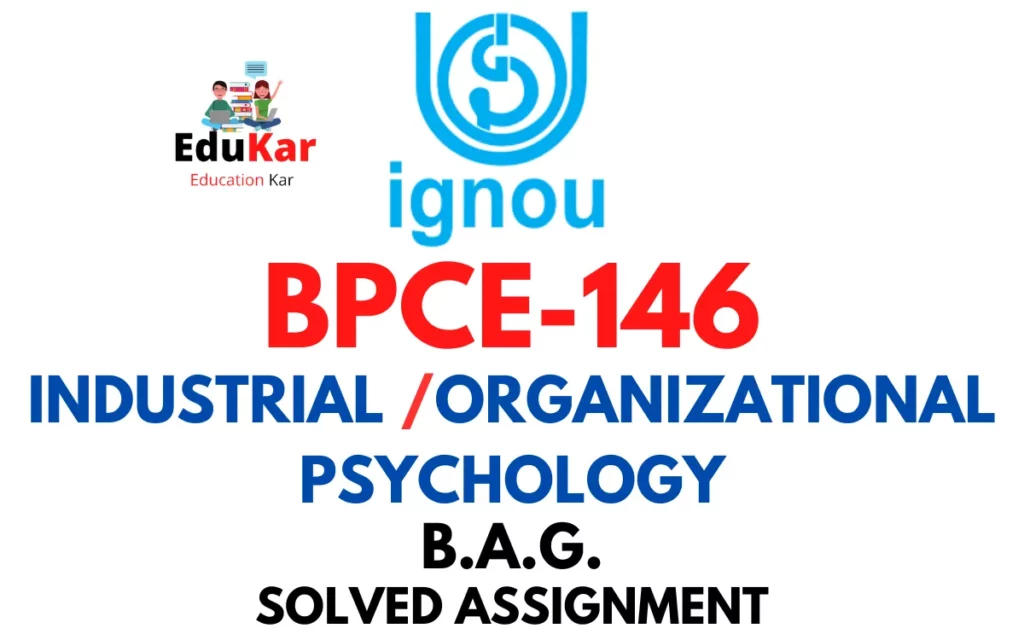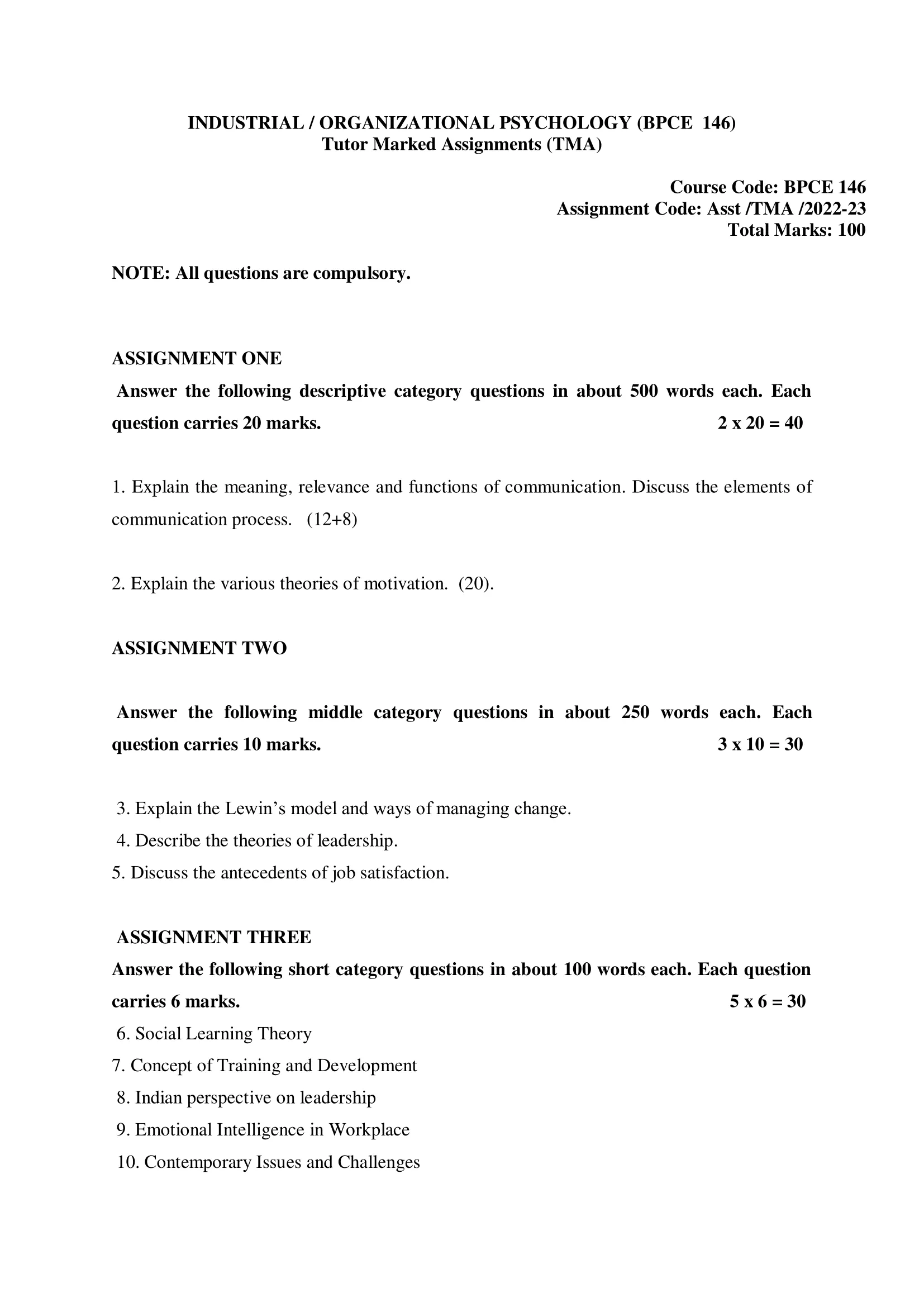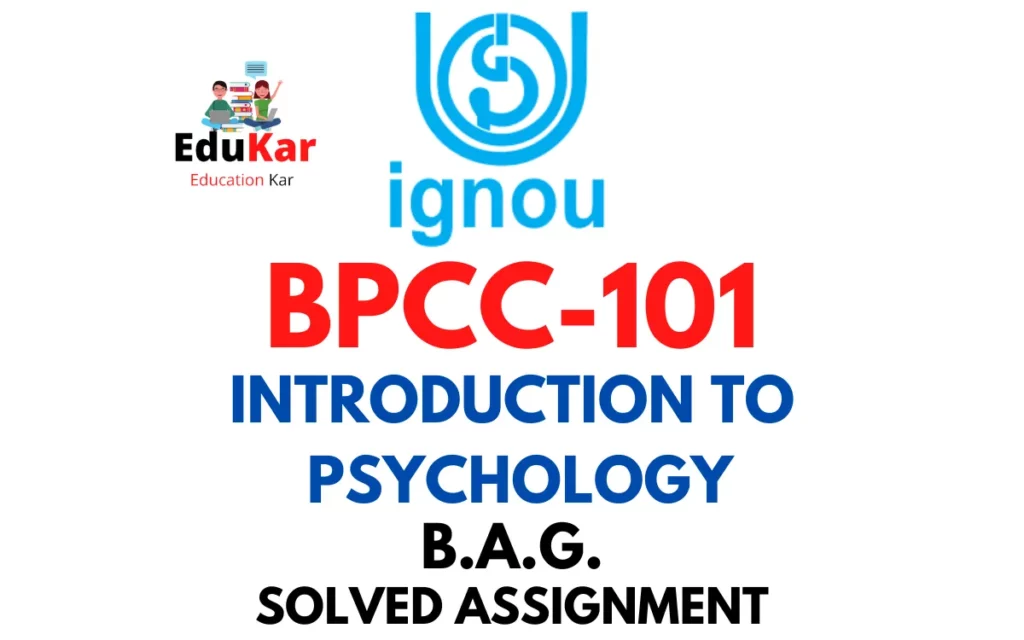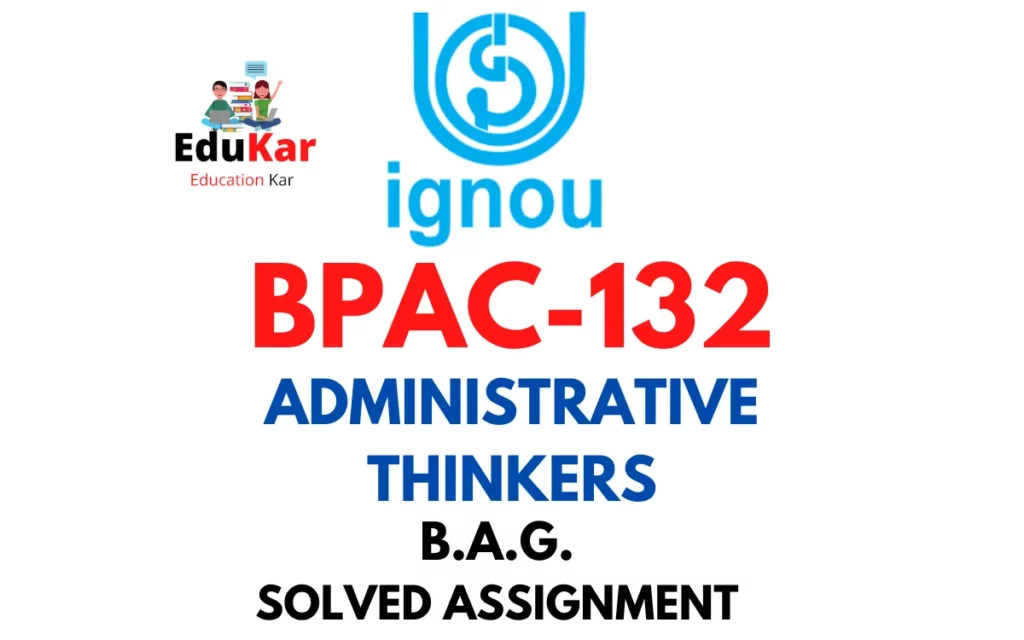Contents
- 1 ASSIGNMENT ONE
- 2 Answer the following descriptive category questions in about 500 words each. Eachquestion carries 20 marks.
- 3 1. Explain the meaning, relevance and functions of communication. Discuss the elements of communication process.
- 4 2. Explain the various theories of motivation.
- 5 ASSIGNMENT TWO
- 6 Answer the following middle category questions in about 250 words each. Eachquestion carries 10 marks.
- 7 3. Explain the Lewin’s model and ways of managing change.
- 8 4. Describe the theories of leadership.
- 9 5. Discuss the antecedents of job satisfaction.
- 10 ASSIGNMENT THREE
- 11 Answer the following short category questions in about 100 words each. Each question carries 6 marks.
- 12 6. Social Learning Theory
- 13 7. Concept of Training and Development
- 14 8. Indian perspective on leadership
- 15 9. Emotional Intelligence in Workplace
- 16 10. Contemporary Issues and Challenges

| Title | BPCE-146: IGNOU BAG Solved Assignment 2022-2023 |
| University | IGNOU |
| Degree | Bachelor Degree Programme |
| Course Code | BPCE-146 |
| Course Name | INDUSTRIAL /ORGANIZATIONAL PSYCHOLOGY |
| Programme Name | Bachelor of Arts (General) |
| Programme Code | BAG |
| Total Marks | 100 |
| Year | 2022-2023 |
| Language | English |
| Assignment Code | Asst /TMA /2022-23 |
| Last Date for Submission of Assignment: | For June Examination: 31st April For December Examination: 30th September |

ASSIGNMENT ONE
Answer the following descriptive category questions in about 500 words each. Each
question carries 20 marks.
1. Explain the meaning, relevance and functions of communication. Discuss the elements of communication process.
Ans: Communication is the process of exchanging information and ideas between individuals or groups. It is an essential tool in our daily lives, as it allows us to convey our thoughts and feelings, make decisions, and build relationships with others. Communication can take many forms, including verbal, nonverbal, written, and visual.
The relevance of communication cannot be overstated. Effective communication is essential for personal and professional success, as it allows individuals to convey their ideas, share their experiences, and build meaningful connections with others. In the workplace, communication is vital for coordinating tasks, achieving goals, and building a positive and productive work environment. In personal relationships, communication is crucial for building trust, resolving conflicts, and maintaining healthy relationships.
The functions of communication can be broadly divided into four categories: informational, persuasive, regulatory, and expressive. Informational communication aims to provide factual information, such as news or data. Persuasive communication aims to influence others, such as in marketing or political campaigns. Regulatory communication involves the exchange of information to maintain order and control, such as in rules and regulations. Expressive communication involves the expression of emotions, feelings, and attitudes.
The elements of the communication process include the sender, the message, the channel, the receiver, feedback, and noise. The sender is the person or entity who initiates the communication, and the message is the information that is conveyed. The channel is the medium through which the message is transmitted, such as speech, text, or body language. The receiver is the person or group who receives the message. Feedback is the response of the receiver to the message, and noise refers to any interference or distortion that may affect the communication process.
2. Explain the various theories of motivation.
Ans: Motivation is the driving force that influences behavior, energizes action, and sustains effort towards achieving a goal. Understanding motivation is essential for employers, educators, and individuals who seek to improve performance, productivity, and well-being. Over the years, many theories of motivation have been proposed, each of which offers a unique perspective on how motivation works. In this answer, we will discuss some of the major theories of motivation.
- Maslow’s Hierarchy of Needs Theory: Abraham Maslow’s theory proposes that people have a hierarchy of needs that must be fulfilled in a particular order. The hierarchy includes physiological needs, safety needs, belongingness and love needs, esteem needs, and self-actualization needs. According to this theory, people are motivated to satisfy lower-level needs before moving up to higher-level needs.
- Herzberg’s Two-Factor Theory: Frederick Herzberg’s theory distinguishes between two types of factors that influence motivation: hygiene factors and motivators. Hygiene factors, such as salary, job security, and working conditions, can prevent dissatisfaction but do not necessarily lead to motivation. Motivators, such as recognition, achievement, and growth, can create satisfaction and motivate individuals to perform at a high level.
- Expectancy Theory: Victor Vroom’s theory proposes that motivation is a result of an individual’s expectations about the relationship between effort, performance, and outcomes. According to this theory, individuals will be motivated when they believe that their effort will lead to high performance and that high performance will lead to desirable outcomes.
- Self-Determination Theory: This theory suggests that individuals are motivated when they feel autonomous, competent, and connected to others. The theory proposes that there are three types of motivation: intrinsic motivation (motivation that comes from within), extrinsic motivation (motivation that comes from external rewards), and amotivation (lack of motivation).
- Goal-Setting Theory: Edwin Locke and Gary Latham’s theory proposes that setting specific and challenging goals can motivate individuals to perform at a high level. According to this theory, goals must be clear, specific, and challenging, and individuals must receive feedback on their progress towards achieving those goals.
- Equity Theory: J. Stacy Adams’ theory proposes that individuals are motivated when they feel that they are treated fairly in comparison to others. According to this theory, individuals compare their input (effort, time, and skills) and output (salary, rewards, and recognition) to others in similar positions. If the comparison reveals inequity, individuals will be motivated to restore equity.
ASSIGNMENT TWO
Answer the following middle category questions in about 250 words each. Each
question carries 10 marks.
3. Explain the Lewin’s model and ways of managing change.
Ans: Kurt Lewin’s Change Management Model is one of the most widely used frameworks for understanding and managing organizational change. The model is based on the idea that change is a three-stage process: unfreezing, changing, and refreezing.
- Unfreezing: The first stage involves creating the motivation and readiness to change. The unfreezing process requires individuals to be open to change and willing to let go of old habits, behaviors, and ways of thinking. It is essential to create a sense of urgency to convince people of the need for change. This may involve sharing data, conducting training sessions, and engaging in open communication.
- Changing: The second stage involves making changes to the organization, people, and processes. During this stage, the organization needs to focus on developing new behaviors, skills, and attitudes that support the change. This may involve restructuring, reorganizing, and realigning resources. Additionally, the change process may also require the creation of new policies, procedures, and systems.
- Refreezing: The final stage involves institutionalizing the changes made during the second stage. During this stage, the changes are reinforced and integrated into the organization’s culture and values. This may involve making sure that the new behaviors and practices are adopted by employees, as well as creating incentives and recognition programs to encourage their continuation.
Ways of Managing Change:
- Communication: Effective communication is essential to ensuring the success of the change process. This means providing clear and consistent messaging about the change, its purpose, and expected outcomes. Communication should be two-way, with leaders seeking input from employees and actively listening to feedback.
- Collaboration: Successful change requires collaboration and engagement from all levels of the organization. This means involving employees in the change process, seeking their input, and providing opportunities for feedback and involvement.
- Leadership: Leadership is essential to managing change effectively. Leaders need to create a sense of urgency, inspire a shared vision, and provide direction and support to employees throughout the change process.
- Training and Development: Organizations should invest in the development of employee skills and capabilities to support the change process. This means providing training and development programs that equip employees with the knowledge and skills necessary to implement the changes effectively.
- Continuous Improvement: Organizational change is an ongoing process, and it is essential to continuously evaluate and refine the changes made. This means monitoring progress, identifying areas for improvement, and making adjustments as needed.
4. Describe the theories of leadership.
Ans: Leadership is a complex and multi-dimensional phenomenon that has been studied and analyzed from various perspectives. There are several theories of leadership, each with its own unique approach to understanding and explaining what makes a good leader. Here are some of the main theories of leadership:
- Trait Theory: This theory suggests that leaders possess certain innate qualities that make them effective leaders. According to this theory, leaders are born, not made. The qualities attributed to successful leaders may include intelligence, self-confidence, integrity, and charisma.
- Behavioral Theory: This theory emphasizes the behaviors that leaders exhibit, rather than their inherent traits. According to this theory, effective leaders possess specific behaviors that enable them to influence and motivate their followers. The two main behavioral approaches are the Ohio State University and the University of Michigan models.
- Situational Theory: This theory argues that the effectiveness of a leader is dependent on the situation in which they find themselves. The situational theory suggests that leaders should adapt their leadership style to fit the needs of their followers and the situation at hand.
- Contingency Theory: This theory suggests that leadership effectiveness is contingent on the leader’s ability to match their leadership style with the specific demands of a given situation. Contingency theory suggests that leaders should adopt different styles of leadership depending on the specific demands of the situation.
- Transformational Theory: This theory emphasizes the leader’s ability to inspire and motivate their followers to achieve their full potential. Transformational leaders are focused on achieving a shared vision and empowering their followers to achieve their goals. They inspire their followers to go beyond their own self-interests and focus on the greater good.
- Authentic Theory: This theory emphasizes the leader’s ability to be genuine and true to themselves while leading others. Authentic leaders are transparent and honest, they build trust and relationships with their followers based on their own core values and beliefs.
- Servant Theory: This theory emphasizes the leader’s ability to serve and empower their followers. Servant leaders focus on the needs of their followers, helping them grow and achieve their potential. They prioritize the growth and well-being of their followers over their own interests.
Each theory of leadership has its own strengths and limitations, and the most effective leaders are those who can draw on multiple theories to adapt their style to different situations and followers.
5. Discuss the antecedents of job satisfaction.
Ans: Job satisfaction is a crucial factor that can impact an employee’s work performance, behavior, and well-being. Several factors contribute to job satisfaction, which can be broadly classified into two categories: intrinsic and extrinsic factors. Here are some of the antecedents of job satisfaction:
- Intrinsic Factors: These are factors that are inherent in the job itself, and they contribute to job satisfaction. Intrinsic factors include:
- Work meaningfulness: The degree to which employees perceive their work as meaningful and purposeful can affect their job satisfaction. Employees who find their work meaningful are likely to be more satisfied than those who don’t.
- Autonomy: The degree to which employees have control over their work can affect their job satisfaction. Employees who have greater autonomy are likely to be more satisfied with their job.
- Variety: The degree to which employees have variety in their work can affect their job satisfaction. Employees who have a greater variety of tasks to perform are likely to be more satisfied with their job.
- Feedback: The degree to which employees receive feedback about their performance can affect their job satisfaction. Employees who receive regular and constructive feedback are likely to be more satisfied with their job.
- Extrinsic Factors: These are factors that are external to the job, and they contribute to job satisfaction. Extrinsic factors include:
- Pay and Benefits: The amount of pay and benefits that employees receive can affect their job satisfaction. Employees who receive fair pay and benefits are likely to be more satisfied with their job.
- Organizational Culture: The organizational culture, including the degree of support, recognition, and appreciation provided by the organization, can affect employee job satisfaction.
- Work-Life Balance: The degree to which employees are able to balance their work and personal lives can affect their job satisfaction. Employees who have a good work-life balance are likely to be more satisfied with their job.
- Job Security: The degree to which employees feel secure in their job can affect their job satisfaction. Employees who feel secure in their job are likely to be more satisfied with their job.
It is important to note that job satisfaction is a complex and multi-dimensional construct, and the antecedents of job satisfaction can vary from person to person. Some factors may be more important to certain individuals than others. Understanding the antecedents of job satisfaction can help organizations to create a work environment that promotes employee job satisfaction and, ultimately, improve overall organizational performance.
ASSIGNMENT THREE
Answer the following short category questions in about 100 words each. Each question carries 6 marks.
6. Social Learning Theory
Ans: The Social Learning Theory, proposed by Albert Bandura, suggests that individuals learn by observing and imitating others’ behavior, attitudes, and emotions. According to this theory, individuals are more likely to imitate the behavior of those they perceive as credible or authoritative. The theory proposes that reinforcement, both positive and negative, can influence the likelihood of individuals imitating a behavior. This theory has implications for areas such as education, therapy, and parenting, as it highlights the importance of modeling and reinforcement in promoting positive behaviors and attitudes.
7. Concept of Training and Development
Ans: Training and development are two closely related concepts that are critical to the success of organizations and individuals.
Training refers to the process of teaching specific skills or knowledge to employees that will help them perform their job duties more effectively. It can include a wide range of activities, such as on-the-job training, classroom training, workshops, seminars, and e-learning.
Development, on the other hand, is a broader concept that refers to the long-term growth and improvement of employees. It involves helping employees acquire new skills, knowledge, and abilities that will enable them to take on new roles and responsibilities within the organization.
Both training and development are essential for the success of an organization. Through training, employees can acquire the skills and knowledge they need to perform their job duties effectively. Through development, employees can continue to grow and improve, and be better prepared to take on new challenges and responsibilities within the organization.
8. Indian perspective on leadership
Ans: Leadership is a critical concept in India, and it has been an important aspect of the country’s cultural, social, and political fabric for thousands of years. In the Indian context, leadership is often viewed as a responsibility rather than a position of power or authority.
There are several key characteristics of leadership in the Indian context, including:
- A focus on service and selflessness: Leaders in India are expected to be servants of the people and to put the interests of the community or organization ahead of their own personal interests. This is reflected in the concept of “seva,” which emphasizes the importance of service and selflessness.
- Respect for hierarchy and authority: In India, there is a deep respect for authority and hierarchy, and leaders are expected to command respect from their subordinates. Leaders are also expected to be knowledgeable and well-educated, and to have a strong sense of ethical and moral values.
- A focus on consensus-building and collaboration: In Indian culture, collaboration and consensus-building are highly valued, and leaders are expected to work with others to achieve common goals. This is reflected in the concept of “sangha,” which emphasizes the importance of community and collaboration.
- A commitment to lifelong learning and personal development: In India, there is a strong emphasis on lifelong learning and personal development, and leaders are expected to continuously improve their knowledge and skills. This is reflected in the concept of “vidya,” which emphasizes the importance of education and knowledge.
9. Emotional Intelligence in Workplace
Ans: Emotional intelligence (EI) is the ability to recognize, understand, and manage one’s own emotions, as well as the emotions of others. In the workplace, EI has become an increasingly important skill for leaders and employees alike. Here are some ways that EI can impact the workplace:
- Better communication: Individuals with high EI are better able to communicate effectively with their colleagues and superiors. They can read nonverbal cues, understand the underlying emotions behind a message, and adjust their own communication style accordingly.
- Improved teamwork: EI can improve teamwork by helping individuals to understand and manage their own emotions, as well as the emotions of their teammates. This can lead to better collaboration, more effective problem-solving, and greater team cohesion.
- Increased empathy: Individuals with high EI are more likely to show empathy towards their colleagues and customers. This can lead to better relationships and increased trust, which is critical in any workplace.
- Better leadership: Leaders with high EI are better able to understand and manage their own emotions, as well as the emotions of their employees. This can lead to more effective leadership, better employee engagement, and higher levels of job satisfaction.
- Enhanced conflict resolution: Individuals with high EI are better able to manage and resolve conflicts in the workplace. They can identify the underlying emotions behind a conflict, and work towards a resolution that is satisfactory for all parties involved.
10. Contemporary Issues and Challenges
Ans: The world is constantly evolving, and with it come new issues and challenges that organizations must navigate to remain competitive and sustainable. Here are some of the contemporary issues and challenges that organizations are facing today:
- Digital Transformation: The digital revolution has transformed the way we live and work, and organizations must keep pace with the latest technologies to remain relevant. Companies must adapt to emerging technologies such as artificial intelligence, big data, and the internet of things to remain competitive.
- Diversity and Inclusion: Diversity and inclusion have become important issues in the workplace. Organizations must create a culture that values and respects differences among employees, including diversity of gender, race, ethnicity, and background.
- Sustainability: Sustainability has become an important issue for organizations, with increasing focus on the environmental impact of business operations. Companies are now expected to reduce their carbon footprint and adopt sustainable practices, such as using renewable energy and reducing waste.
- Globalization: Globalization has led to increased competition and complexity in the business world. Organizations must adapt to new markets, cultural differences, and global supply chains to remain competitive.
- Workforce Development: With the rapid pace of technological change, employees must continually develop new skills to remain relevant. Organizations must invest in training and development programs to ensure that their employees have the skills and knowledge required to succeed in a changing business environment.
- Ethical Challenges: Organizations must navigate complex ethical challenges, including data privacy, transparency, and social responsibility. Companies must maintain high ethical standards to maintain the trust of their customers and stakeholders.
- Work-Life Balance: Organizations must balance the needs of their employees with the needs of the business. Organizations must provide flexible work arrangements and other benefits to help employees balance their work and personal lives.
These contemporary issues and challenges require organizations to be agile, adaptable, and innovative. Organizations that can navigate these challenges effectively will be well-positioned for long-term success.
How to Download BPCE-146 Solved Assignment?
You can download it from the www.edukar.in, they have a big database for all the IGNOU solved assignments.
Is the BPCE-146 Solved Assignment Free?
Yes this is absolutely free to download the solved assignment from www.edukar.in
What is the last submission date for BPCE-146 Solved Assignment?
For June Examination: 31st April, For December Examination: 30th October












![[Solved Assignment] BPCS 185-DEVELOPING EMOTIONAL COMPETENCE (IGNOU-BAG) 2022-2023 [Solved Assignment] BPCS 185-DEVELOPING EMOTIONAL COMPETENCE (IGNOU-BAG) 2022-2023](https://edukar.in/wp-content/plugins/contextual-related-posts/default.png)



